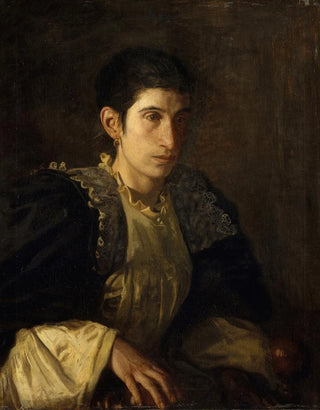Art print | Madame Gomez d'Arza - Thomas Eakins


View from behind

Frame (optional)
Madame Gomez d'Arza - Thomas Eakins – Captivating Introduction
In the fascinating world of art, some works transcend the mere frame to become witnesses of an era, reflections of the human soul. "Madame Gomez d'Arza" by Thomas Eakins is one of these iconic pieces. Painted at the end of the 19th century, this artwork not only showcases the undeniable talent of the artist but also offers a unique vision of femininity and beauty. The depiction of Madame Gomez d'Arza, with her penetrating gaze and natural elegance, invites the viewer to immerse themselves in a world where intimacy and psychological depth intertwine. This painting is much more than a simple portrait; it is an exploration of human emotions, a celebration of feminine grace.
Style and uniqueness of the work
Thomas Eakins's style is often characterized by striking realism and meticulous attention to detail, and "Madame Gomez d'Arza" is no exception. The artist employs a palette of rich, nuanced colors to capture light and shadow in a way that brings his subject to life. The composition is carefully orchestrated, with each element of the artwork contributing to the overall harmony. Madame Gomez d'Arza's face, delicately lit, seems to almost vibrate with inner energy, while the darker background accentuates her radiance. This contrast between the subject and the background creates an atmosphere of mystery and depth, inviting the viewer to ponder the thoughts and feelings of the depicted woman. Eakins thus manages to transcend the simple portrait to offer a complex, emotional psychological vision.
The artist and his influence
Thomas Eakins, a prominent figure in American art history, established himself as a pioneer of realism in the 19th century. His innovative approach and commitment to visual truth influenced many artists of his time and future generations. Eakins did not merely reproduce reality; he sought to capture the very essence of his subjects, whether they were human figures or scenes from everyday life. His interest in human psychology and his attention to detail make him a forerunner in the art of portraiture.

Matte finish

View from behind

Frame (optional)
Madame Gomez d'Arza - Thomas Eakins – Captivating Introduction
In the fascinating world of art, some works transcend the mere frame to become witnesses of an era, reflections of the human soul. "Madame Gomez d'Arza" by Thomas Eakins is one of these iconic pieces. Painted at the end of the 19th century, this artwork not only showcases the undeniable talent of the artist but also offers a unique vision of femininity and beauty. The depiction of Madame Gomez d'Arza, with her penetrating gaze and natural elegance, invites the viewer to immerse themselves in a world where intimacy and psychological depth intertwine. This painting is much more than a simple portrait; it is an exploration of human emotions, a celebration of feminine grace.
Style and uniqueness of the work
Thomas Eakins's style is often characterized by striking realism and meticulous attention to detail, and "Madame Gomez d'Arza" is no exception. The artist employs a palette of rich, nuanced colors to capture light and shadow in a way that brings his subject to life. The composition is carefully orchestrated, with each element of the artwork contributing to the overall harmony. Madame Gomez d'Arza's face, delicately lit, seems to almost vibrate with inner energy, while the darker background accentuates her radiance. This contrast between the subject and the background creates an atmosphere of mystery and depth, inviting the viewer to ponder the thoughts and feelings of the depicted woman. Eakins thus manages to transcend the simple portrait to offer a complex, emotional psychological vision.
The artist and his influence
Thomas Eakins, a prominent figure in American art history, established himself as a pioneer of realism in the 19th century. His innovative approach and commitment to visual truth influenced many artists of his time and future generations. Eakins did not merely reproduce reality; he sought to capture the very essence of his subjects, whether they were human figures or scenes from everyday life. His interest in human psychology and his attention to detail make him a forerunner in the art of portraiture.






